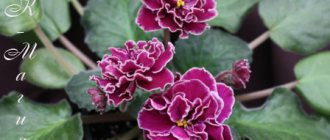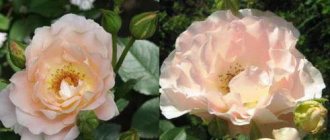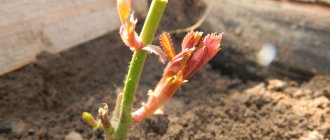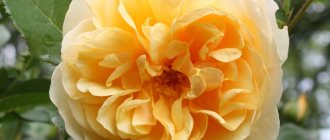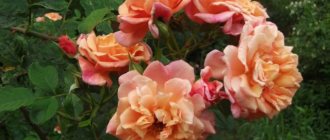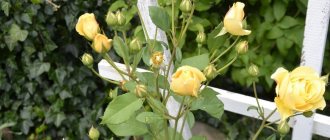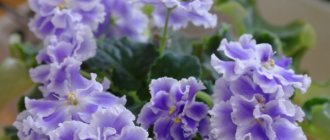Uzambara violet.
Family Gesneriaceae - Gesneriaceae.
Genus Saintpaulia hybrida - Hybrid Saintpaulia.
African violet saintpaulia hybrid.
Violets from breeders of the CIS countries - “D” (EK).
EK- Dolce Vita (E. Korshunova).
EK-Dolche Vita (E. Korshunova)..
Very large (6 cm) double wavy coral-pink stars with a wide crimson-purple frill along the edge of the petals. The sport EK-Love and Pigeons (E. Korshunova) is registered from him.
Her rosette is really very neat and does not grow from flowering to flowering. Standard.
The border and fantasy are beautiful. 4-5 huge flowers bloom on one peduncle, and strong peduncles can withstand all this beauty.
The peculiarity of this variety is that they gain their beauty some time after flowering. At first, the flowers appear ugly, with small petals and large stamens, the color is pale. And then the flower grows, enlarges and gains brightness. It blooms for a long time, the others have time to grow and catch up. In acidic soil the color becomes more vibrant.
Dolce vita is an Italian phraseological unit. It means the “sweet life” of rich, satiated people in bourgeois society. Also a film by F. Fellini (1959).
Do you know that…?
The tendency to sapling is a varietal trait or an error in agricultural technology. In some varieties it is very pronounced, in others it is not. Stepchildren on miniature and semi-miniature varieties are a nuisance much more often than on standard varieties of violets. And often the massive appearance of stepsons indicates that the first flower stalks will soon appear. Both children and adult plants produce stepsons; you need to regularly check them for stepchildren. Stepchildren need to be mercilessly removed, but pay closer attention; sometimes tiny flower stalks already appear next to the stepchildren.
Before you buy the violets listed below, carefully read the forums about their behavior on the windowsill. Many of them are very beautiful flowers. However, these can be large rosettes with large and fragile leaves, with leaves rising up or hugging the pot, forming many stepsons that interfere with the formation of a neat rosette, pulling the stem up and growing into a Christmas tree, bending the trunk, rare flowering with long breaks, fallen flowers or they last little and quickly wither, very long and recumbent peduncles, the color of the flower fades quickly, they do not like bright lighting on the windowsill, they are afraid of the slightest drying out or waterlogging, a large percentage of them go into sports or darken the flower.
Are they suitable for your window sill and the conditions that you can create for them? You will look at the flowers for several months, and the rosette will always be in front of your eyes. There are many beautiful flowers, there are much fewer beautiful and neat rosettes, look first at the rosette! Search and you may find a dozen violets with the same flower color if you are not interested in the smallest details as a collector.
• — Lady with Camellias (Korshunova); • — Victory Day (Korshunova); • — Birthday (Korshunova); • — Amazon Jungle (Korshunova);
Today, on the windowsills of avid flower growers, you can see a variety of representatives of the violet family: with patterns, inclusions, spots, stripes, stains and contrasting borders.
One of the interesting varieties of violets with richly colored buds is Dolce Vita. Its huge bright flowers will not leave any collector indifferent, and caring for it will be a real pleasure.
Description, photographs and features of the variety
Dolce Vita violets are another development of the domestic breeder Elena Korshunova, who introduced this magnificent variety to the world in 2005. The Italian phraseology “Dolce vita” means “sweet life” or “not life, but raspberries,” as evidenced by the rich coral-pink palette of flowers. Today, two sports are officially registered from Dolce Vita - Love and Pigeons.
According to the description, these violets have a neat emerald rosette and double wavy coral-pink flowers with a wide crimson-purple edging along the border of the petals, which can be seen in the photo. The flowers reach 6 cm in diameter and are shaped like stars. They do not have a pronounced aroma.
According to the description, the variety has several characteristic features:
- the rosette has a standard size and does not grow from flowering to flowering;
- fairly strong flower stalks can support 4-5 large flowers;
- all the beauty of these violets begins to appear some time after blooming: at first the flowers are pale in color and have small petals and large stamens, over time they begin to increase in size and gain brightness;
- the plant blooms for a long time, the remaining flowers have time to grow and catch up;
- When grown in acidic soil, the color becomes more intense.
EK-Dolce Vita
Discussion of Saintpaulia varieties selected by Elena Korshunova.
Moderator: Floriana
Inna S. Messages: 2246 Registered: May 27, 2010, 17:43 Awards: 20 From: Ukraine
EK-Dolce Vita
#1
Post by Inna S. » June 14, 2010, 11:49 pm
Saintpaulia EK-Dolce Vita (E. Korshunova).
Very large (6 cm) double wavy coral-pink stars with a wide crimson-purple frill along the edge of the petals. The photo shows the sports version.
Inna S.
Perl Messages: 1797 Registered: 07 Sep 2009, 22:18 Awards: 24 From: Volzhsky, Volgograd region.
Re: EK-Dolce Vita (E. Korshunova)
#3
Post by Perl » Jun 24, 2010, 02:37 pm
Inna, you have her very beautiful, but this is a sport, although not worse than the class. Once, when breeding, I also got a sport and variety. Sport has larger flowers than cultivar. Unfortunately the photo did not survive.
Perl
Inna S. Messages: 2246 Registered: May 27, 2010, 17:43 Awards: 20 From: Ukraine
Re: EK-Dolce Vita (E. Korshunova)
#4
Post by Inna S. » June 24, 2010, 5:53 pm
Why is this a sport? Because of the wide fuzzy border? So the same rosette can bloom differently. Plant the plant on a starvation diet and there will be a thin, clear border. Verified.
Inna S.
Inna S. Messages: 2246 Registered: May 27, 2010, 17:43 Awards: 20 From: Ukraine
EK-Dolce Vita (E. Korshunova)
#7
Post by Inna S. » 06 Jan 2011, 21:54
The rosette is average, grows without any “bells and whistles”. If the children have petioles of different colors, there will be options with different intensities of coloring of the flowers. But all the options are very beautiful! From the lightest to the darkest!
Inna S.
Elena M. Messages: 4544 Registered: Oct 22, 2010, 10:49 pm Awards: 21 From: Moscow
Re: EK-Dolce Vita (E. Korshunova)
#11
Message Elena M. » 07 May 2011, 01:44
Inna S.
Nothing like this. I had the same sport. The color did not change either in the old soil or in the new (more nutritious) soil. And the varietal specimen also did not change the width of the border. In terms of variety, it is pink with a fuchsia border, but clearly not with a fuchsia fantasy that turns into a border.
BJILKA has a good, pure specimen.
Elena M.
Basic rules of care and maintenance
Properly growing violets and caring for them is a whole science. A factor in healthy growth and flowering is compliance with a number of rules, from organizing the correct location to the ability to feed a plant in need in a timely manner.
Location and lighting
Representatives of the Dolce Vita variety love good, but diffused light. To ensure that violets receive a sufficient amount of natural light, it is advisable to place them on windows facing east or west. Placing it on the south side can cause sunburn on the leaves, so in this case the pot is placed on a table opposite the window sill, and the window panes are shaded with a curtain or mosquito net to diffuse the rays.
Subject to artificial lighting, violets require a 12-hour daylight hours, provided by fluorescent lamps.
Temperature and humidity
The optimal temperature at which violets exist comfortably is 18-22 degrees throughout the year. Humidity in the room should be maintained at 50-60%, so if the air is excessively dry, humidifiers and the old method of hanging wet towels on radiators are used.
The Dolce Vita violet requires an air humidity of about 60%.
Interesting. Some gardeners claim that if you leave the plant alone for 6 weeks at a low temperature (13-15 degrees) and reduced watering, the flowering will be more abundant and larger. This technique stimulates the setting of more flower buds and can be used at any time of the year.
Watering
Violets are watered on average 2-3 times a week, depending on the characteristics of the soil, air humidity and season. Water for irrigation should be at room temperature and allowed to stand for at least 24 hours. You can use melted, boiled or filtered water.
Care instructions
The Dolce Vita rose does not require any special care, only standard measures for the culture:
- watering - usually once a week is enough for the bush; an adult plant spends 20-25 liters of water. In hot weather, water the rose more often, every 2–3 days. Water is poured exclusively at the root; drops that fall on the leaves and buds have a negative impact on the decorative appearance of the bush, and flowers may fall off;
Irrigation from a watering can or hose for a blooming Dolce Vita rose is a categorical taboo
Mulching is an optional measure that will make the life of a gardener much easier. Mulch allows you to save time on loosening and weeding, and water the rose less often;
Mulching for roses is a very useful agrotechnical measure.
fertilization - the variety needs 4–5 fertilizing per season (from April to September). The first is necessarily nitrogen-containing (mineral fertilizer or natural organic matter), then, at intervals of a month and a half, store-bought fertilizers for roses (or phosphorus and potassium) are used;
Try proven fertilizers:

